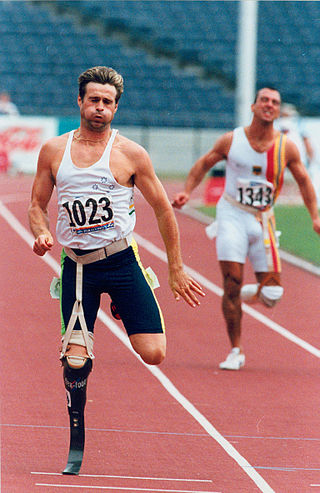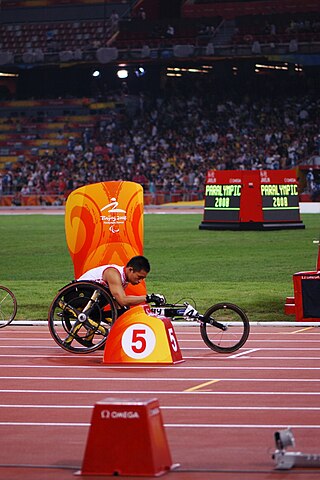
T44 is a disability sport classification for disability athletics, applying to "Single below knee amputation or an athlete who can walk with moderately reduced function in one or both legs." It includes ISOD A4 and A9 classes.

T53 is disability sport classification for disability athletics. The class includes people with a number of different types of disabilities including spinal cord injuries. People in this class have full use of their arms but have no or limited trunk function. Similar classifications are T51, T52, and T54. People in this class have a functional upper limbs, but limited trunk usage and limited lower limb functionality. During classification, they both undergo a bench test of muscle strength and demonstrate their skills in athletics. People in this class include Tanni Grey-Thompson (GBR), Samantha Kinghorn (GBR), Angie Ballard (AUS) and Richard Colman (AUS).
Disability sports classification is a system that allows for fair competition between people with different types of disabilities.
Wheelchair basketball classification is the system that allows for even levels of competition on the court for wheelchair basketball based on functional mobility. The classifications for the sport are 1 point player, 2 point player, 3 point player, 4 point player and 4.5 point player, the greater the player's functional ability. Classification for the sport is set by the International Wheelchair Basketball Federation.
Para-athletics classification is a system to determine which athletes with disabilities may compete against each other in para-athletics events. Classification is intended to group together athletes with similar levels of physical ability to allow fair competition. Classification was created and is managed by the International Paralympic Committee (IPC), which is regularly published via its IPC Athletics Classification Handbook. People with physical, vision and intellectual disabilities are eligible to compete in this sport at the Summer Paralympics. The classification for this sport was created during the 1940s and for much of its early history was a medical condition based classification system. The classification system has subsequently become a functional mobility based one, and is moving towards an evidence-based classification system.
Para-swimming classification is a function-based classification system designed to allow for fair competition in disability swimming. The classes are prefixed with "S" for freestyle, butterfly and backstroke events, "SB" for breaststroke and "SM" for individual medley events. Swimmers with physical disabilities are divided into ten classes based on their degree of functional disability: S1, S2, S3, S4, S5, S6, S7, S8, S9 and S10. The lower number indicates a greater degree of impairment. Those with visual impairments are placed in classes S11, S12 and S13. Class S15 is for athletes with hearing loss. Additional classes may be reserved for swimmers with intellectual impairment: S14, S18 for swimmers with Down Syndrome or class-S14 intellectual impairment combined with a physical impairment, and S19 for swimmers with autism.
Para-cycling classification is the process of classifying participants in para-cycling covering four functional disability types. The classification system includes classes for handcycles for people who have lower limb mobility issues. The sport is governed by the Union Cycliste Internationale (UCI).

Para-Nordic skiing classification is the classification system for para-Nordic skiing which includes the biathlon and cross-country events. The classifications for Para-Nordic skiing mirrors the classifications for Para-Alpine skiing with some exceptions. A functional mobility and medical classification is in use, with skiers being divided into three groups: standing skiers, sit skiers and visually impaired skiers. International classification is governed by International Paralympic Committee, Nordic Skiing (IPC-NS). Other classification is handled by national bodies. Before the IPC-NS took over classification, a number of organizations handled classification based on the type of disability.

Para-archery classification is the classification system for para-archery used to create a level playing field for archers with a different range of disabilities. Governance in the sport is through the International Archery Federation. Early classification systems for the sport were created during the 1940s and based on medical classification. This has subsequently changed to a functional mobility classification with the exception of blind archery.
Paralympic powerlifting classification is the system designed for disability based powerlifting to ensure that there is level competition across a range of disabilities. Categories are broken down based on weight. The sport's classification is governed by International Paralympic Committee Powerlifting. People with physical disabilities are eligible to compete in this sport.
Paralympic Shooting classification is the shooting classification in place for the Paralympic Games to help establish fair competition. Classification is governed by the International Paralympic Committee's IPC Shooting. While there are currently three classifications, there were originally five in international competitions. People with physical disabilities as defined by the International Paralympic Committee are eligible to compete.
Wheelchair rugby classification is the seven class system that assigns players a point value based on functional mobility to ensure parity in athletic ability on the court at any given time. Classification is handled by the International Wheelchair Rugby Federation.
Wheelchair fencing classification is the classification system for wheelchair fencing which is governed by the IWAS. People with physical disabilities are eligible to compete included people with physical disabilities. Classification for national competitions is done through the local national Paralympic committee.
Disability table tennis classification is the disability sport classification process for para table tennis that is governed by the International Table Tennis Federation. The sport's classifications are open to people with physical and intellectual disabilities.
Para-equestrian classification is a system for para-equestrian sport. It is a graded system based on the degree of physical or visual disability and handled at the international level by the FEI. The sport has eligible classifications for people with physical and vision disabilities. Groups of eligible riders include The sport is open to competitors with impaired muscle power, athetosis, impaired passive range of movement, hypertonia, limb deficiency, ataxia, leg length difference, short stature, and vision impairment. They are grouped into five different classes to allow fair competition. These classes are Grade I, Grade II, Grade III, Grade IV, and Grade V(Grade Names Changed as of Jan 2017). The para-equestrian classification does not consider the gender of the rider, as equestrines compete in mixed gender competitions.
Disability sailing classification is the method of allowing sailors with different disabilities to compete, with classification being based on vision, mobility, stability and hand function. Classification is handled by the International Association for Disabled Sailing (IFDS).
Boccia classification is the classification system governing boccia, a sport designed specifically for people with disabilities. Classification is handled by Cerebral Palsy International Sports and Recreation Association. There are four classifications for this sport. All four classes are eligible to compete at the Paralympic Games.
Football 7-a-side classification is the classification system governing Football 7-a-side. The classifications are governed by the Cerebral Palsy International Sports and Recreation Association (CP-ISRA).

Para-equestrian is an equestrian sport governed by the International Federation for Equestrian Sports (FEI), and includes two competitive events. One is para-equestrian dressage, which is conducted under the same basic rules as conventional dressage, but with riders divided into different competition grades based on their functional abilities. The other is para-equestrian driving, which operates under the same basic rules as combined driving but places competitors in various grades based on their functional abilities.
Les Autres sport classification is system used in disability sport for people with locomotor disabilities not included in other classification systems for people with physical disabilities. The purpose of this system is to facilitate fair competition between people with different types of disabilities, and to give credibility to disability sports. It was designed and managed by International Sports Organization for the Disabled (ISOD) until the 2005 merger with IWAS, when management switched to that organization. Classification is handled on the national level by relevant sport organizations.





